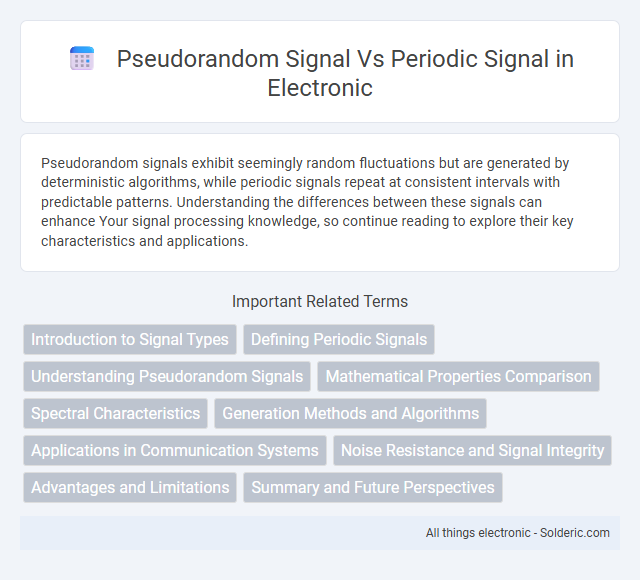Pseudorandom signals exhibit seemingly random fluctuations but are generated by deterministic algorithms, while periodic signals repeat at consistent intervals with predictable patterns. Understanding the differences between these signals can enhance Your signal processing knowledge, so continue reading to explore their key characteristics and applications.
Comparison Table
| Feature | Pseudorandom Signal | Periodic Signal |
|---|---|---|
| Definition | Signal with deterministic but seemingly random patterns | Signal that repeats at regular intervals |
| Predictability | Deterministic yet unpredictable without key | Fully predictable and repeatable |
| Frequency Spectrum | Broad, noise-like spectral content | Discrete spectral lines at harmonics |
| Applications | Cryptography, spread spectrum, noise simulation | Clocks, oscillators, communication carriers |
| Periodicity | Quasi-periodic or aperiodic over long intervals | Exact repetition with defined period |
| Generation | Algorithmic sequences (e.g., LFSR, M-sequences) | Oscillators, signal generators |
| Amplitude Characteristics | Variable, pseudo-random amplitude distribution | Consistent amplitude pattern |
Introduction to Signal Types
Pseudorandom signals exhibit non-repetitive, noise-like patterns generated deterministically for applications in communications and system testing, contrasting sharply with periodic signals, which repeat at regular intervals defined by a fundamental frequency. Periodic signals such as sine waves are characterized by their precise frequency components and predictable time-domain behavior, facilitating Fourier analysis and filtering. Pseudorandom signals enhance security and spectral efficiency by simulating randomness while maintaining reproducible properties useful in spread spectrum technologies and system identification.
Defining Periodic Signals
Periodic signals repeat their values at regular intervals over time, characterized by a fixed period T and frequency f. These signals possess a consistent pattern, enabling predictable behavior in time and frequency domains. Your understanding of periodic signals is crucial for distinguishing them from pseudorandom signals, which lack such regular repetition despite appearing noise-like.
Understanding Pseudorandom Signals
Pseudorandom signals appear noise-like yet follow deterministic algorithms, making them predictable over time unlike purely random signals. These signals are crucial in communications and cryptography, where their reproducibility ensures secure and efficient data transmissions. Your understanding of pseudorandom signals helps differentiate them from periodic signals, which repeat at constant intervals and exhibit predictable patterns ideal for synchronized systems.
Mathematical Properties Comparison
Pseudorandom signals exhibit statistical properties similar to random noise, such as a flat power spectral density and low autocorrelation except at zero lag, distinguishing them mathematically from periodic signals that repeat exactly over regular intervals with discrete frequency components. Unlike periodic signals represented by harmonic sine and cosine functions with predictable Fourier series, pseudorandom signals lack strict periodicity, yet their deterministic generation allows for reproducible sequences critical in communication systems and cryptography. Understanding these differences in autocorrelation and spectral characteristics helps optimize your signal processing tasks for applications requiring either predictable periodicity or noise-like randomness.
Spectral Characteristics
Pseudorandom signals exhibit a continuous and flat spectral density resembling white noise, allowing for a wide frequency distribution without prominent peaks. Periodic signals display discrete spectral lines at fundamental frequencies and their harmonics, reflecting their repetitive nature. The spectral characteristics of pseudorandom signals enable better insight in system identification and spread spectrum communications, while periodic signals are essential in conventional signal processing and communications where frequency purity is required.
Generation Methods and Algorithms
Pseudorandom signals are generated using algorithms such as Linear Feedback Shift Registers (LFSR), M-sequences, and Gold codes that produce sequences mimicking randomness while maintaining deterministic reproducibility. Periodic signals are synthesized through mathematical functions like sine and cosine waves or through Fourier series expansions, ensuring consistent repetition over fixed intervals. Your choice between these generation methods depends on whether you need deterministic pseudorandomness for applications like secure communications or strict periodicity for signal processing tasks.
Applications in Communication Systems
Pseudorandom signals, known for their noise-like properties and deterministic generation, are widely used in spread spectrum communication and secure data transmission to enhance resistance against interference and eavesdropping. Periodic signals, characterized by their consistent frequency and amplitude, play a critical role in carrier wave generation and synchronization in traditional communication systems such as amplitude and frequency modulation. The choice between pseudorandom and periodic signals directly impacts system performance in terms of security, bandwidth efficiency, and robustness against multipath fading.
Noise Resistance and Signal Integrity
Pseudorandom signals exhibit superior noise resistance compared to periodic signals due to their wide frequency spectrum, which enhances signal integrity in noisy environments. Your communication system benefits from reduced interference and improved data accuracy when using pseudorandom sequences, as their low correlation properties minimize signal distortion. Periodic signals, while simpler, are more susceptible to predictable noise patterns that can degrade overall signal quality and reliability.
Advantages and Limitations
Pseudorandom signals offer enhanced security and resistance to interference due to their noise-like properties, making them ideal for spread spectrum communication and encryption applications. However, their generation and synchronization require complex algorithms and processing power compared to periodic signals, which provide simplicity and predictability in timing-critical systems. Your choice depends on whether you prioritize robustness and security with pseudorandom signals or ease of implementation and exact timing with periodic signals.
Summary and Future Perspectives
Pseudorandom signals exhibit complex, noise-like patterns with deterministic generation, contrasting periodic signals characterized by consistent, repeating waveforms essential for synchronization in communication systems. Advances in pseudorandom signal design enhance secure data transmission and radar applications by improving unpredictability and resistance to interference. Future perspectives involve integrating machine learning algorithms to optimize pseudorandom sequence generation and leveraging hybrid systems combining pseudorandom and periodic signals for robust, adaptive wireless networks.
Pseudorandom signal vs periodic signal Infographic

 solderic.com
solderic.com